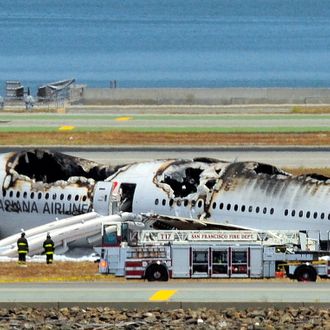
We don’t know yet what caused Asiana Flight 214 carrying 307 people to belly-flop onto the seawall short of Runway 28L at San Francisco International Airport on Saturday, killing two and injuring scores of others. Investigators from the National Transportation Safety Board are reportedly interviewing the four Asiana pilots to learn more about just what was going down inside the cockpit of the Boeing 777 in those final seconds before the plane smacked the ground and burst into flames.
So far, there have been no reports of the pilots declaring any mechanical problems prior to the crash. As James Fallows points out, speculation in the immediate aftermath of an accident is often proved wrong by later evidence. However, the unique circumstances of this crash raise some larger questions about flying today that will be relevant no matter what the NTSB ultimately finds in its official report months from now.
One of the reasons this accident has sparked intense public attention — besides the cable-news treatment — is that it occurred on a brilliantly clear morning, when planes are not supposed to fall out of the sky. All airline crashes are terrifyingly random, but in this case the ideal weather conditions amplify the sense of freakishness.
With regard to what was happening in the cockpit, what we know so far is troubling. The 777 was losing both airspeed and altitude with no apparent corrections from the pilots. Three seconds from impact, the plane was doing just over 100 knots, far below the target speed of 137 knots. Why did the pilots let this happen? That’s what NTSB chief Deborah Hersman and her team will find out. But at this point it seems that the pilots stopped flying the airplane. At a news conference yesterday, Hersman said, “We have a flying pilot and we have two other pilots that are in the cockpit and they have a monitoring function. One of the very critical things that needs to be monitored on an approach to landing is speed.” Much has been made of the news that SFO’s instrument landing system was inoperable on the morning of the crash. But pilots should have no problem flying visual approaches in clear weather.
Pilots today are, in a sense, technology managers. Modern cockpits look sort of like a Wall Street trading desk, filled with banks of flat-screen computer monitors displaying data. At major airports, Category III Instrument Landing Systems are precise enough to allow a plane’s autopilot to fly the approach right down to the numbers (some airports, like London’s Heathrow, actually can handle auto landings). The New York Times reports that pilots for some Asian airlines are so comfortable with the computerized systems that they are reluctant to “hand fly” the airplane. But as we know from the excesses of Wall Street, blind faith in technology is no substitute for common sense.
While advanced technology has undoubtedly made airline travel safer (the last fatal accident in the United States was in 2009), it also means that pilots have fewer opportunities to actually fly airplanes. The instruments in modern airline cockpits can be like high-performance running shoes: All that gadgetry can make a pilot’s underlying skills atrophy.
My father, an experienced instrument-rated pilot who has logged serious hours flying through New England winters and summer thunderstorms, always impressed upon me the singular importance of flying the airplane. If you don’t like the way an approach is shaping up, you go around. If something seems off, fly the airplane above all else. Were the pilots of Asiana 214 embarrassed to declare a missed approach in such clear conditions? We don’t know. But the evidence indicates they started out high and fast, cut the power to slow down, and then let the speed deteriorate without advancing the throttles until it was too late. Somewhere along the decision chain, they stopped flying the plane.
Recent accidents suggest that the spread of automation is a double-edged sword for aviation. The February 2009 crash of Colgan Air flight 3407 outside of Buffalo was caused by the sleep-deprived regional pilot’s failure to monitor his airspeed. In that case, the gaps between automated systems and manual systems contributed to the crash. The Bombardier Q400 commuter plane is equipped with an autopilot but no auto-throttle. It was the pilots’ job to set the appropriate power settings to maintain the proper speed. When the pilots failed to increase thrust, the plane’s autopilot valiantly tried to maintain altitude until the plane’s “stick shaker” went off, indicating a stall. The plane lost lift and crashed five miles from the runway, killing all 49 people onboard and one person on the ground.
Four months later, the mysterious crash of Air France flight 447 off the coast of Brazil (228 dead) was another chilling case of the perils of technology superseding piloting. The official French accident report found that the crash happened after the Airbus A330’s navigation systems went haywire in bad weather (ice crystals caused the plane’s airspeed sensor, called a Pitot tube, to malfunction). In the cockpit, the airspeed readout on the pilot’s flight display indicated that the plane was losing speed precipitously. In reality, it wasn’t. Instead of stopping to assess the actual flight conditions — not easy in a violent thunderstorm — the confused and stressed pilot pulled back on the control stick when he should have flown level. Stall alarms sounded as the plane pitched up to 35 degrees and plunged into the Atlantic Ocean. As The Wall Street Journal reported in 2011, the crash “could have been avoided if the pilots had received more training, particularly in manual flying and recognizing stalls at high altitudes.”
What happened at SFO? The NTSB will give us the answers behind the crash. No matter what, the accident can serve as a reminder that there is no amount of advanced technology that will substitute for the pilot’s most important job: flying the airplane.





























